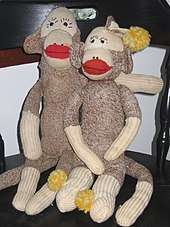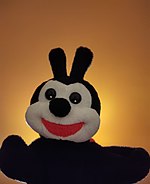Stuffed toy
A stuffed toy is a toy with an outer fabric sewn from a textile and stuffed with flexible material. They are known by many names, such as plushies, stuffed animals, plush toys, or stuffies. In Britain and Australia, they may be called soft toys or cuddly toys. Textiles commonly used for the outer fabric include plain cloth, as well as pile textiles like plush or terrycloth, or even socks. Common stuffing materials include synthetic fiber, batting, cotton, straw, wood wool, plastic pellets, and beans. The toy originates from Germany in the late 19th century and has been marked by fads in popular culture that sometimes affected collectors and the value of the toys.

Stuffed toys are made in many different forms, but most often resemble real animals (sometimes with exaggerated proportions or features), legendary creatures, cartoon characters, or inanimate objects. They can be used as comfort objects; for display or collecting; or given as gifts, such as for graduation, illness, condolences, Valentine's Day, Christmas, or birthdays. They are commonly gifted to children, but can be given to anybody.
Description
Stuffed toys are distinguished from other toys primarily by their softness, flexibility and their resemblance to animals or fictional characters. Stuffed toys most commonly take the form of animals, especially bears (in the case of teddy bears), mammalian pets such as cats and dogs, and highly recognizable animals such as zebras, tigers, pandas, lizards, and elephants. The popularity of stuffed toys is such that one can almost always find a stuffed toy version of any fictional character from a movie, TV show, book or other entertainment form, so long as it is animal-like. Stuffed toys of both real and fictional humans are also seen on shelves regularly, given that the individual or character is famous enough.
Stuffed toys come in an array of different sizes, with the smallest being thumb-sized and the largest being larger than a house. However, the largest somewhat commonly-produced stuffed animals are not much bigger than a person. The majority of stuffed animals are between a few inches tall and a foot tall or more. They also come in a wide variety of colours and fur textures.
Stuffed toys are commonly sold in stores worldwide. Vendors are often abundant at tourist attractions, airports, carnivals, fairs, downtown parks, and general public meeting places of almost any nature, especially if there are children present.
History

The first commercial concern to create stuffed toys was the German Steiff company in 1880. Steiff used newly developed technology for manufacturing upholstery to make their stuffed toys.[1] In 1892, the Ithaca Kitty became one of the first mass-produced stuffed animal toys in the United States.[2]

In 1903 Richard Steiff designed a soft stuffed bear that differed from earlier traditional rag dolls, because it was made of plush furlike fabric.[1] At the same time in the US, Morris Michtom created the first teddy bear after being inspired by a drawing of President "Teddy" Roosevelt with a bear cub.[3] In 1903, the character Peter Rabbit from English author Beatrix Potter was the first stuffed toy to be patented.[4]
Types
Handcrafted
Amigurumi is a Japanese type of handcrafted knitted or crocheted stuffed toys. Amigurumi are typically made to look cute with oversized heads and undersized extremities.[5][6]
Sock monkeys are a type of handmade stuffed monkey made out of socks, which first appeared in the US during the Great Depression.[7]

Brands
Brands of stuffed toys include Pillow Pets, whose toys can be folded from a pillow into a stuffed animal; Tickle Me Elmo, a laughing and shaking plush toy based on the character Elmo from the Sesame Street television show, released in 1996;[8] Furby, a robotic talking plush toy with its own language, released in 1998;[9] and Zhu Zhu Pets, a line of robotic plush hamsters released in 2009.[10][11]
Some brands of stuffed toys used marketing strategies to encourage the collection of a series of stuffed toys.[12] One of the most notable stuffed toy collections includes Beanie Babies.
Virtual brands
Webkinz stuffed animals were created by Ganz in 2005. Each Webkinz toy comes with a unique "Secret Code" that gives access to the Webkinz World website and a virtual version of the toy for online play.[13][14] Disney's Club Penguin and Build-A-Bearville from Build-A-Bear Workshop were formerly other online worlds with content that could be unlocked from codes found on associated stuffed toys. In 2013, Disney launched its first collection of Disney Tsum Tsum stuffed toys based on characters from different Disney properties, inspired by the popular app of the same name.[15]
Impact
Stuffed toys are among the most played-with toys of children. Their size and softness makes them ideal for toddlers, since it is almost impossible for them to be injured by one. However, they are not exclusively for toddlers, and are often played with by children right up into their pre-teens. Their resemblance to characters or animals allows for imaginative free play, especially with other children, and there is no real limit on the amount of time one can spend playing with them. Stuffed toys do sometimes tear, but with a sewing needle and rudimentary sewing skills, the damage is often easily repairable. Their low price, combined with their demand, means that it is common for children to possess tens of stuffed toys at a single time. Some households report having stuffed toys numbering in the hundreds.
See also
| Wikimedia Commons has media related to Stuffed animals. |
| Look up soft toy or stuffed toy in Wiktionary, the free dictionary. |
References
- Gary S. Cross (1999). Kids' Stuff: Toys and the Changing World of American Childhood. Harvard University Press. pp. 93–94. Archived from the original on 2016-01-04.
- Sachse, Gretchen (2016-07-28). "Ithaca Kitty was a success across America". The Ithaca Journal. Ithaca, New York. Retrieved 2016-08-02.
- "Teddy Bears". Library Of Congress. Archived from the original on 2009-12-05. Retrieved 2007-12-10.
- "The life of Beatrix Potter - Peter Rabbit". peterrabbit.com. Archived from the original on 2012-01-17.
- Mary Beth Temple (2009). Hooked for Life: Adventures of a Crochet Zealot. Andrews McMeel. pp. 40–41. ISBN 978-0-7407-7812-4. Retrieved 2010-03-20.
Amigurumi.
- Mary Belton (2006). Craft, Volume 1: Transforming Traditional Crafts. O'Reilly Media. pp. 41–42. ISBN 978-0-596-52928-4. Archived from the original on 2017-12-28. Retrieved 2010-03-20.
- Boschma, Janie (2007-11-05). "History of the sock monkey: Stuffed animal created during the Great Depression". The Spectator. Archived from the original on 2009-12-18. Retrieved 2009-07-01.
- "Just Tickled" Archived 2014-06-02 at the Wayback Machine. People, January 13, 1997.
- "New toy an interactive fur ball". CNN. 1998-10-05. Archived from the original on 2007-06-16. Retrieved 2007-07-13.
- Vicki Mabrey; Kinga Janik (November 20, 2009). "Zhu Zhu Pets: Hamsters to Save Christmas?". ABC News. Archived from the original on November 22, 2009.
- Anderson, Mae (November 27, 2009). "Robotic hamsters are holidays' unlikely new craze". Denver Post. Archived from the original on June 29, 2011. Retrieved May 18, 2011.
- Wickman, Kase (August 30, 2017). "The Life and Death of the Princess Diana Beanie Baby Market". Vanity Fair. Condé Nast. Retrieved June 5, 2019.
- Pardo, Steve (2007-04-11). "Kids hooked on Webkinz world". The Detroit News. Retrieved 2007-04-23.
- Barakat, Matthew (2007-07-13). "Review: Webkinz pleases parents and children". NBC News. Retrieved 2007-08-20.
- "Disney Store Releases Alice in Wonderland Tsums!". Tsum Tsum Central. Archived from the original on 2016-03-04. Retrieved 2015-10-08.
